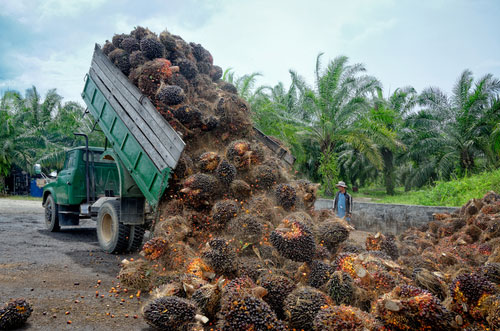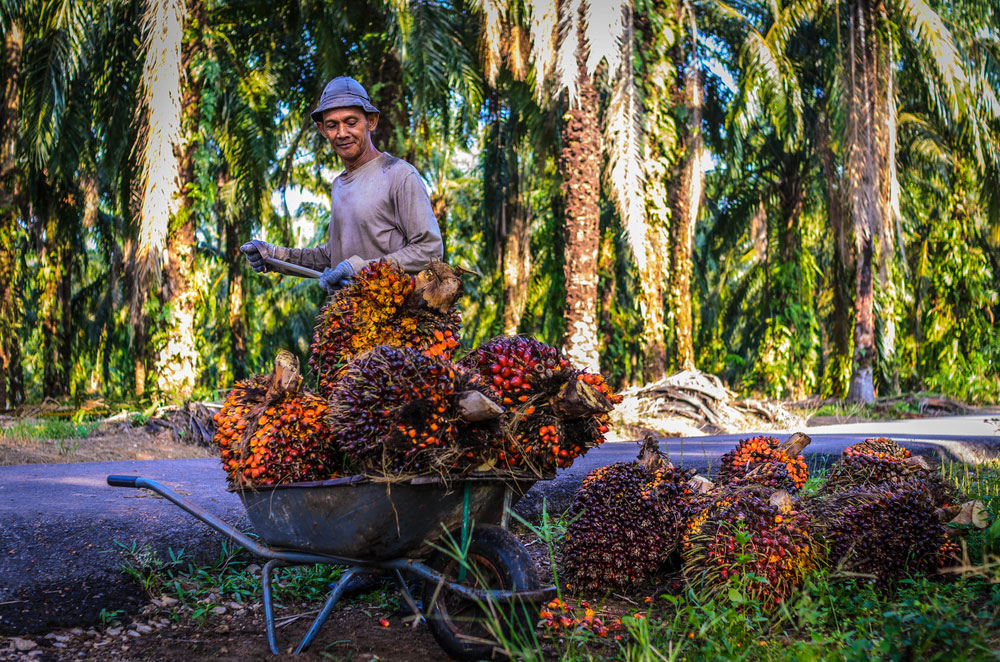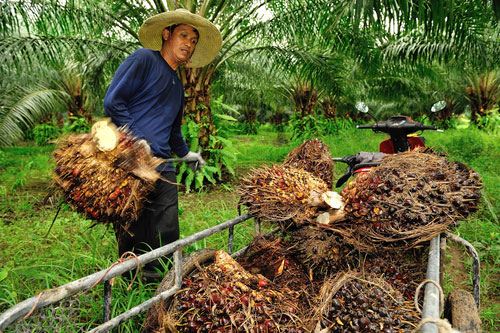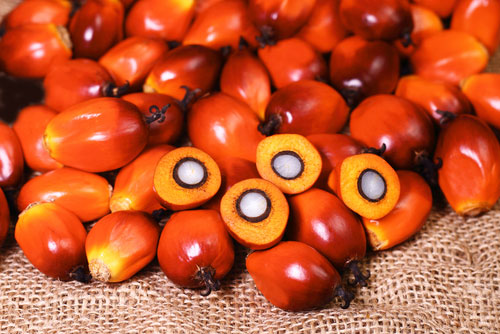Palm oil is present in around 50% of the products you see when you go to the supermarket. Due to its massive use and efficiency, it is being overexploited – destroying ecosystems, biodiversity and supporting unfair human rights practices. Because of this, some companies have already started to demand that the palm oil they buy as an ingredient for their products is sustainably produced. But can these sustainability certification processes be trusted? Let’s find out.
[mwm-aal-display]
Where Can You Find Palm oil? Which Products Have It?
What is palm oil? It’s a kind of vegetable oil that is obtained from the fruit and seeds of the oil palm. This tree, originally from West Africa, is nowadays present in most tropical regions and is massively planted in Indonesia and Malaysia. In fact, these countries are the 2 main exporters of palm oil, responsible for ~85% of the world’s supplies, which means 69,3 million tons in 2018. Worldwide, it’s estimated that 27 million hectares of land is occupied for growing palm trees – a landmass that has the approximate size of New Zealand.
But where can we find palm oil? In almost all processed foods and in many other products. Due to its flexible characteristics, this oil can be used to improve the food’s texture and connect ingredients, to make the cooking process faster, to hold colors well, among other uses. Next time you go to the supermarket, check the labels more carefully. See the ingredients present in the instant noodles, pizza doughs, chocolate bars, cookies, packaged bread or margarine, to name a few. You’ll probably find palm oil is over there. You’ll also find it in your lipstick, shampoo, soap or perfume. And in candles and car fuel too. Make no mistake, even if its business name isn’t in the label, palm oil responds by many names due to its controversy.
[box] Here’s a list of ingredients you might find labeled that contain palm oil, according to WWF:
Vegetable Oil, Vegetable Fat, Palm Kernel, Palm Kernel Oil, Palm Fruit Oil, Palmate, Palmitate, Palmolein, Glyceryl, Stearate, Stearic Acid, Elaeis Guineensis, Palmitic Acid, Palm Stearine, Palmitoyl Oxostearamide, Palmitoyl Tetrapeptide-3, Sodium Laureth Sulfate, Sodium Lauryl Sulfate, Sodium Kernelate, Sodium Palm Kernelate, Sodium Lauryl Lactylate/Sulphate, Hydrated Palm Glycerides, Ethyl Palmitate, Octyl Palmitate, Palmityl Alcohol [/box]
Apart from its versatility, there are also 2 other big reasons why palm is so used that justifies all this hype: price and efficiency. Yes, palm oil is sold at a cheap price and it is an incredibly efficient crop – it has a better yield per hectare and requires less fertilizer and pesticides than other alternative oils. For instance, while soy and rapeseed crops typically need 315kg and 99kg of fertilizer to produce one tonne of oil, palm oil needs, on average, 49kg. And while 1 hectare of palm oil crop produces 3,62 tonnes of palm oil, the same area only produces 0,3 and 0,79 tonnes of soybean and rapeseed oil, respectively.
All these arguments make palm oil a very important commodity for many industries and for the international markets as well. It also means a lot to the local communities who produce and get a living from it. In fact, palm oil exportations from Indonesia were worth US$20.75 billion in 2015 and this industry directly employed 5.6 million people, according to RSPO. In Malaysia, the agricultural sector contributed to the country’s 2016 GDP in 8,1% (US$21,35 billion) – and palm oil represented 43% of this income. These numbers have been increasing since last year, since the production in Malaysia increased by 15.0%, reaching 19.92 million tonnes compared to 17.32 million tonnes in 2016.
All this sounds great, right? Not really – let’s figure out why.
Why Palm Oil Can Be Unsustainable And Bad For The Planet

But what’s wrong with palm oil after all? The palm oil industry is a complex problem that starts with the excessive and counterproductive production of palm oil leading tropical forests to be taken down. Much of this deforestation happens because as palm trees grow and get higher, it gets more difficult to collect their fruits and seeds – that will further be used to make palm oil. Because of this, many producers clean down old palm trees and rainforests to plant new trees.
This deforestation doesn’t only mean reducing Earth’s ability to capture CO2 and therefore leaving the planet more vulnerable to global warming and to climate change. This cleaning may also mean environmental pollution, since forest and land fires, including peatland fire, are a common method to prepare the land for palm trees plantations. These fires cause smoke and toxic haze and can be very harmful to the health of local people. At the same time, in Europe, half of the palm oil imports are used to fill up the tanks of vehicles that run on diesel – palm oil is used as a biofuel, which means it is a fuel additive. Aware of these impacts, the EU banned the subsidies for the imports of palm oil that’d be used for this end, effective in 2020.
But palm oil still has other environmental consequences. Growing crops for palm oil is also related to big biodiversity losses since many animals – such as orangutans, of which 100.000 disappeared in the last 16 years – are left without a home. In fact, a recent study from WWF pointed that “nature, underpinned by biodiversity, provides a wealth of services, which form the building of blocks of modern society; but both nature and biodiversity are disappearing at an alarming rate”. Part of it happens because of deforestation, partly caused by palm oil exploitation, together with the mass production of other crops such as soy or coffee.
- Related:
Why Palm Oil Can Be Bad For The Local People

The development of palm trees plantations is oftentimes promoted as a form of bringing development to poor and rural regions in countries like Indonesia, Malaysia or Thailand. Nevertheless, local governments often end up allowing corporations to take control of lands what used to be “owned” or inhabited by indigenous people who aren’t properly compensated for their loss. In order to survive, these people need to become plantation workers and they stay dependant to the palm oil industry, as they are no longer able to sustain themselves like they used to.
According to the Borneo Project, human and employee rights are often violated in these “working contracts”. The story told is that many companies hire low-wage employees (and their families) to manually move big amounts of palm oil. Other workers are said to be living in supervised barracks with few living conditions. As well, according to the “say no to palm oil” movement, children who are people forced to work and to carry large loads of weed fields. Others spend many hours per day bending over to collect fallen tree fruits – many face heat exhaustion, cuts, and bruises from the trees’ spikes and don’t even get paid.
So we’ve seen that this industry can have a negative impact on the environment of the planet and in people’s lives. Does this mean that palm oil should be banned?
Palm Oil Sustainable Certification Can Be The Solution

As we’ve seen above, palm oil is a very efficient oil, and other more efficient or more eco-friendly oils haven’t been found, at least not yet. Due to the global pressure on this commodity, most of which coming from India and China but also from other developing countries, it’d be senseless to ban palm oil. Other less eco-efficient oils would have to be produced to face the existing demand and other regions such as Brazil would end up being “punished” instead.
What seems to be the best solution so far is to create pressure so that organizations get a sustainable palm oil certification. WWF has launched the most recognized certification standards on this matter – the Roundtable on Sustainable Palm Oil (RSPO). It is made up by industry players who have united forces to set criteria for certified palm oil that reduces the negative results of palm tree crops. By establishing harsh production standards to all stages of palm oil manufacturing, this certification allows companies to demonstrate that oil palm plantations don’t need to grow at the expense of rainforests or human rights.
Still, and despite the fact that 2,4 million hectares of land were certified in 2018, and that 13,6 million tones of certified sustainable palm oil (CSPO) were produced, CSPO is still a niche market that accounts for only 19% of the total market, according to RSPO’s 2018 Impact Report. For the expansion of the CSPO market, more companies who use palm oil in their products need to get certified and prove that they really care about people & planet. And us, consumers, should be alert and buy products from brands and companies using CSPO and suggest them to source this type of palm oil if they want our vote, i.e., that we choose their products.
Do Sustainable Palm Oil Certifications Have Flaws?

But there’s still a major issue: the trading system that allows companies to buy sustainable palm oil seems rigged. Greenpeace published a report on this topic in late 2018 in an attempt to identify the problems behind palm oil traders and producers n Indonesia and Malaysia. Theoretically, the “No deforestation, no peat, no exploitation” (NDPE) policies allow companies to source palm oil that doesn’t lead to deforestation or loss of peatland and that respects human dignity while keeping the soil and land healthy. But according to Greenpeace, even when trusting traders that stand up to be NDPE certified, companies are not guaranteed to buy sustainable palm oil. In fact, the certification system often fails to monitor the suppliers across all of the operations to determine whether they comply with these policies.
The report decrypts how traders don’t fully care to track their suppliers’ operations – and lack to ensure if they are compliant with NDPE policies or whether they are destroying forests in protected areas. In reality, some producers still aren’t compliant and produce dirty palm oil from forbidden and protected areas and employ under miserable conditions, and traders often miss the identification of such producers… As a result, multinationals that have made promises of being people & planet friendly fail to deliver these same promises.
According to the report, an efficient way to clean up the palm oil industry would be for all sectors involved, including producers, traders, and consumer companies, to join efforts and act together – as RSPO is trying to encourage. Nonetheless, as traders and other companies are resisting to do so and they’re lacking transparency, the report ends up suggesting that consumer companies must lead the way. They say it’s up to these companies to the drive change throughout the palm oil sector by taking control of and responsibility for their own supply chains while encouraging other producers and traders to promote sustainable productions too.
How To Develop The Sustainable Palm Oil Market?

Sustainable palm oil is a complex issue. In order to develop a truly sustainable palm oil supply chain, the local governments will also have a role to play, by enforcing norms and laws that help strengthen the CSPO and RSPO’s standards. Such policies could, for instance, force companies to make sure that local farmers were getting fair earnings and having good working conditions. Of course, these laws would have to be created together with complex processes that would ensure and verify that companies were complying. International governments and institutions could also develop regulations asking for palm oil entering international markets to be certified.
Every day we play a consumer role and choose the products and brands from which we’re buying from. If we’re aware of what’s happening behind the shelves, we can also do something. We can decide not to buy or to buy fewer products from companies and brands that don’t act responsibly about palm oil. We can also let these companies know, through their customer support services, that we’d like them to support CSPO and complain about why they’re not doing it yet. By doing all these, we are pushing companies to act on this issue and increasing the chances that they’ll pay more attention to their traders and suppliers and consider sourcing CSPO.
And in the end, this quest isn’t only about making sure that the sources of palm oil are clean and sustainable. It’s also about encouraging the industry to find alternatives to this specific oil (such as algae oil perhaps – studies are still in progress), finding time to cook more at home (and buying less processed foods that contain palm oil) or also using public transportation or walking more often (because of biofuel).
As for a lot of human activities, if managed properly, the production of palm oil can be effective and sustainable. But problems arise when mass production and industrialization encourage economic actors to use bad practices and to break the rules. The permanent race for cheap palm oil to sustain the mass market of industrial goods leads to a cascade of problems: deforestation, human rights abuses, corruption… Despite the efforts to create good sustainability certification systems, there’s still a long way to go before palm oil can be called “sustainable” worldwide. To achieve this goal, the palm oil industry will need the engagement of each of its stakeholders, from consumers and consumer good companies, to local governments and institutions.
Image credits: industry production on Shutterstock; production on Shutterstock; trees and orangutans on Shutterstock, rural agriculture on Shutterstock, people working on Shutterstock & fruit seeds production on Shutterstock.

